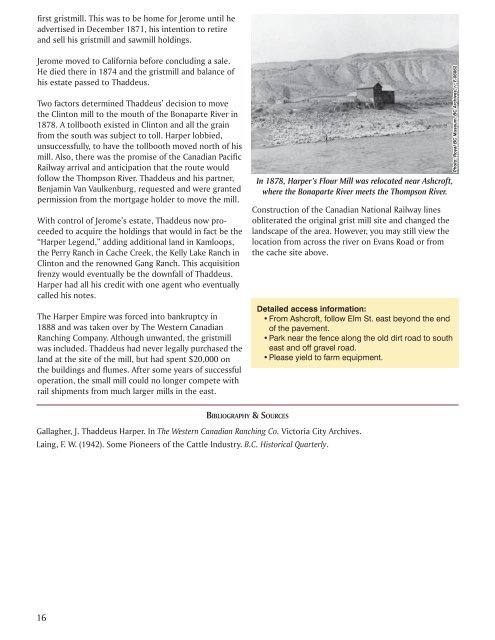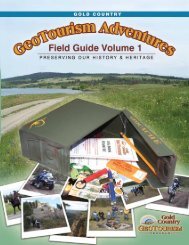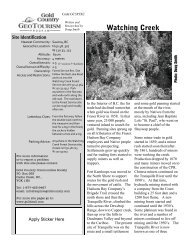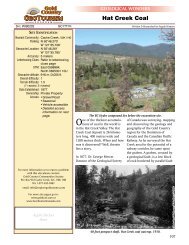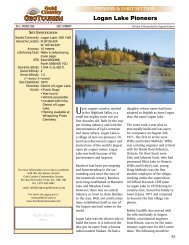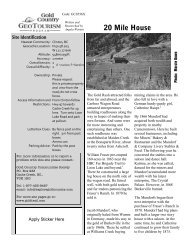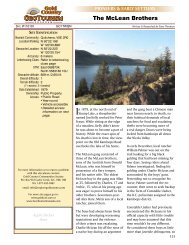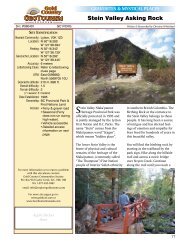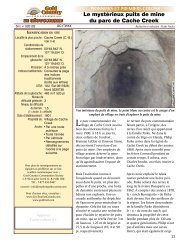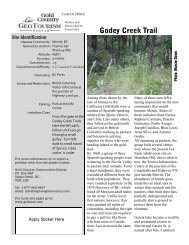E book Field Guide.indd - Gold Country
E book Field Guide.indd - Gold Country
E book Field Guide.indd - Gold Country
Create successful ePaper yourself
Turn your PDF publications into a flip-book with our unique Google optimized e-Paper software.
first gristmill. This was to be home for Jerome until he<br />
advertised in December 1871, his intention to retire<br />
and sell his gristmill and sawmill holdings.<br />
Jerome moved to California before concluding a sale.<br />
He died there in 1874 and the gristmill and balance of<br />
his estate passed to Thaddeus.<br />
Two factors determined Thaddeus’ decision to move<br />
the Clinton mill to the mouth of the Bonaparte River in<br />
1878. A tollbooth existed in Clinton and all the grain<br />
from the south was subject to toll. Harper lobbied,<br />
unsuccessfully, to have the tollbooth moved north of his<br />
mill. Also, there was the promise of the Canadian Pacific<br />
Railway arrival and anticipation that the route would<br />
follow the Thompson River. Thaddeus and his partner,<br />
Benjamin Van Vaulkenburg, requested and were granted<br />
permission from the mortgage holder to move the mill.<br />
With control of Jerome’s estate, Thaddeus now proceeded<br />
to acquire the holdings that would in fact be the<br />
“Harper Legend,” adding additional land in Kamloops,<br />
the Perry Ranch in Cache Creek, the Kelly Lake Ranch in<br />
Clinton and the renowned Gang Ranch. This acquisition<br />
frenzy would eventually be the downfall of Thaddeus.<br />
Harper had all his credit with one agent who eventually<br />
called his notes.<br />
The Harper Empire was forced into bankruptcy in<br />
1888 and was taken over by The Western Canadian<br />
Ranching Company. Although unwanted, the gristmill<br />
was included. Thaddeus had never legally purchased the<br />
land at the site of the mill, but had spent $20,000 on<br />
the buildings and flumes. After some years of successful<br />
operation, the small mill could no longer compete with<br />
rail shipments from much larger mills in the east.<br />
In 1878, Harper’s Flour Mill was relocated near Ashcroft,<br />
where the Bonaparte River meets the Thompson River.<br />
Construction of the Canadian National Railway lines<br />
obliterated the original grist mill site and changed the<br />
landscape of the area. However, you may still view the<br />
location from across the river on Evans Road or from<br />
the cache site above.<br />
Detailed access information:<br />
• From Ashcroft, follow Elm St. east beyond the end<br />
of the pavement.<br />
• Park near the fence along the old dirt road to south<br />
east and off gravel road.<br />
• Please yield to farm equipment.<br />
Photo: Royal BC Museum, BC Archives, n o F-06862<br />
BIBLIOGRAPHY & SOURCES<br />
Gallagher, J. Thaddeus Harper. In The Western Canadian Ranching Co. Victoria City Archives.<br />
Laing, F. W. (1942). Some Pioneers of the Cattle Industry. B.C. Historical Quarterly.<br />
16


